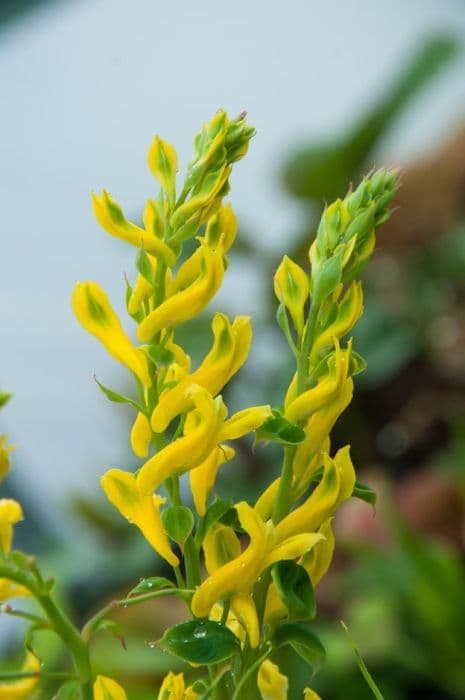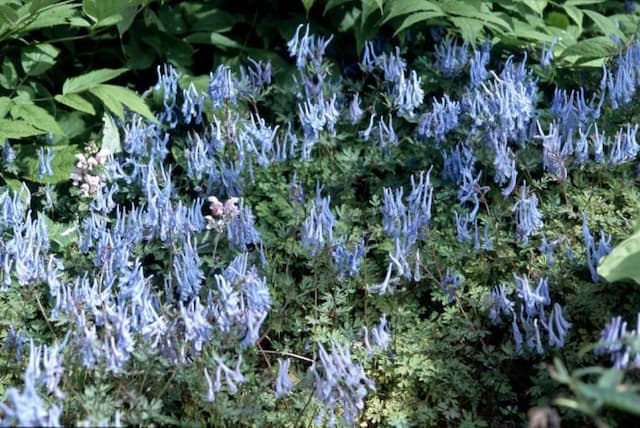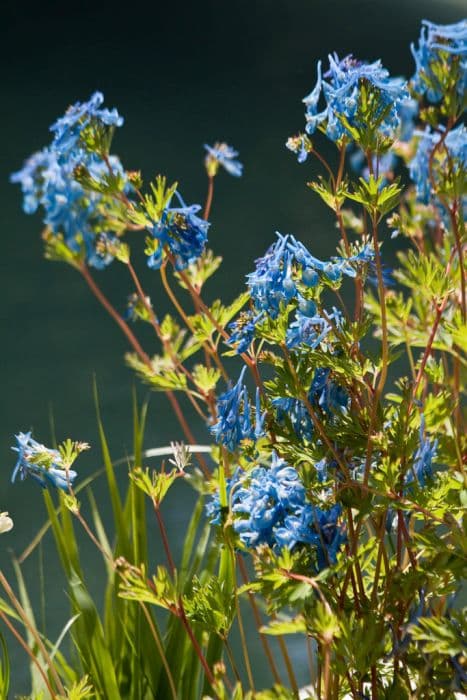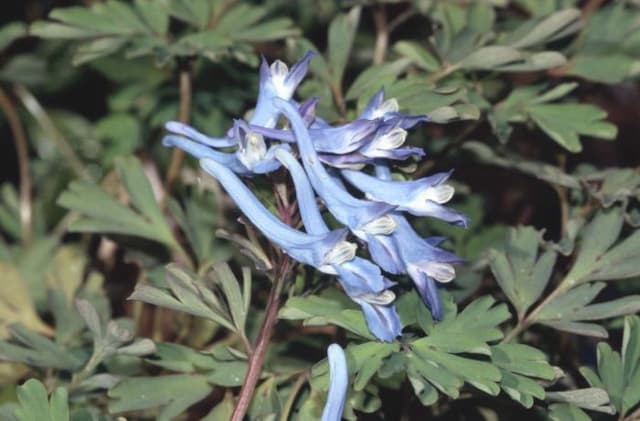Oriental Poppy Papaver (Oriental Group) 'Karine'

ABOUT
Oriental poppy 'Karine' is a striking perennial with large, showy flowers that create a magnificent display in mid to late spring. The blooms are typically a soft yet vibrant hue of pink, nodding on strong stems above a bed of deeply cut, hairy foliage. The foliage is usually green, providing a lush backdrop for the flowers. Each spectacular flower features delicate, tissue paper-like petals that may have a crepe texture, adding a sense of depth and elegance to its appearance. At the core of the flower is a dark, rounded center, often a deep purple or black, which contrasts sharply with the soft pink petals. This center is surrounded by a dramatic series of stamens, adding to the ornamental value of the plant. Once the blooming period is over, the flowers will give way to unique seed pods that hold ornamental interest in the garden. The pods can also be dried and used in floral arrangements. Oriental poppy 'Karine' is recognized for its durable nature in the right conditions, surviving through winter dormancy to burst into vivid life during its blooming season. It prefers full sun but will tolerate some shade and enjoys well-drained soil. After the flowers fade and the foliage dies back, leaving the bare stalks in the summer, the plant may reemerge with fresh foliage growth in the fall.
About this plant
 Names
NamesSynonyms
Oriental Poppy, Karine Oriental Poppy.
Common names
Papaver orientale 'Karine'.
 Toxicity
ToxicityTo humans
The plant commonly known as Oriental poppy may contain alkaloids that can be toxic to humans if ingested. While toxicity is usually considered mild, ingestion can lead to symptoms such as stomach pain, nausea, vomiting, and drowsiness. It is important to handle the plant with care and to ensure that children are taught not to ingest any parts of the plant.
To pets
Similarly, the Oriental poppy can be toxic to pets if they consume parts of the plant. The alkaloids present can cause symptoms that include drooling, loss of appetite, sedation, pupil dilation, ataxia (uncoordinated movements), and in severe cases, respiratory depression. If a pet ingests any part of an Oriental poppy, it is advised to seek veterinary care immediately.
 Characteristics
CharacteristicsLife cycle
Perennials
Foliage type
Deciduous
Color of leaves
Green
Flower color
Pink
Height
2-3 feet (60-90 cm)
Spread
1-2 feet (30-60 cm)
Plant type
Herb
Hardiness zones
3-7
Native area
Asia
Benefits
 General Benefits
General Benefits- Ornamental Appeal: The Papaver 'Karine' adds stunning visual interest to gardens with its large, cup-shaped flowers and vibrant colors.
- Attracts Pollinators: This plant attracts bees, butterflies, and other beneficial pollinators, which are essential for the pollination of many plants.
- Drought Tolerance: Once established, these poppies are relatively drought tolerant, making them suitable for xeriscaping or gardens in drier climates.
- Low Maintenance: They require minimal care once established, making them ideal for gardeners seeking low-maintenance plants.
- Seasonal Interest: Poppies provide seasonal interest with their late spring to early summer blooming period, filling the garden with color after spring bulbs have faded.
- Deer Resistant: These plants are generally resistant to deer, which can be beneficial in areas where deer browsing is a problem.
 Medical Properties
Medical PropertiesThis plant is not used for medical purposes.
 Air-purifying Qualities
Air-purifying QualitiesThis plant is not specifically known for air purifying qualities.
 Other Uses
Other Uses- Poppies like 'Karine' are commonly used in dried floral arrangements due to their striking seed pods that add a unique architectural element to bouquets.
- The dried seed pods of the Poppy can also serve as natural rattles for musical instruments or as sound elements in art projects.
- The petals of the Poppy 'Karine' can be pressed and included in handmade paper, providing a decorative and textured effect to the finished product.
- Poppy 'Karine' is sometimes used in photography as a subject for practicing macro photography skills due to its intricate structures and vibrant colors.
- The intense pigment in the petals can be used as a natural dye for fabrics, offering a variety of pink to red hues.
- Poppy petals have also been incorporated into artisanal soaps and candles for visual appeal and as a nod to natural ingredients.
- Crafters sometimes use Poppy seed heads in creating eco-friendly jewelry, such as pendants or earrings, by coating them in a protective layer of clear resin.
- In gourmet cooking, Poppy 'Karine' flowers can be crystallized with sugar and used as edible decorations for desserts.
- These flowers are incorporated into temporary garden installations or urban landscaping projects for their beauty and ability to attract pollinators.
- Poppies like 'Karine' can be used in natural pest control strategies, as they attract beneficial predatory insects that feed on common garden pests.
Interesting Facts
 Feng Shui
Feng ShuiThe Oriental Poppy is not used in Feng Shui practice.
 Zodiac Sign Compitability
Zodiac Sign CompitabilityThe Oriental Poppy is not used in astrology practice.
 Plant Symbolism
Plant Symbolism- Peace: The poppy, a common name for the Papaver genus, has long been a symbol of peace, especially after being associated with the remembrance of soldiers who died during war due to its prevalence on European battlefields.
- Rest: Poppies are often associated with sleep and rest, as opium, derived from certain Papaver species, has been used as a sedative.
- Rememberance: Particularly red poppies are widely recognized symbols of remembrance for fallen soldiers, especially noted in the poem "In Flanders Fields," as they were the first flowers to bloom on soldiers' graves in World War I.
- Resilience: Despite their delicate appearance, poppies are capable of thriving in difficult environments, symbolizing resilience and the ability to endure challenges.
- Beauty and success: With their striking appearance, poppies can represent both beauty and success, with the notion of vibrant life and reward.
 Water
WaterOriental Poppies, such as 'Karine', should be watered deeply but infrequently to encourage deep root growth. The soil should be allowed to dry out between watering sessions. Generally, watering once a week with 1 to 1.5 gallons of water should suffice, but this depends on the climate and soil drainage. During hot, dry periods, they may need more frequent watering. It's important to avoid overwatering, as Oriental Poppies do not like soggy soil and can develop root rot if kept too wet.
 Light
LightOriental Poppies like 'Karine' thrive in full sun where they can receive at least 6 hours of direct sunlight per day. The ideal spot is one that's sheltered from strong winds but still receives unfiltered sunlight. Avoid placing them in deep shade or very low light areas as this can affect their blooming and overall health.
 Temperature
TemperatureOriental Poppies perform best in temperatures ranging between 50 and 75 degrees Fahrenheit. They can tolerate winter cold down to at least 20 degrees Fahrenheit but are not suited to extreme heat, where temperatures consistently exceed 90 degrees Fahrenheit. The ideal temperature range encourages healthy growth and optimal blooming.
 Pruning
PruningPrune Oriental Poppies after they have finished blooming, usually in late spring or early summer. Remove spent flower stems to tidy up the plant and potentially encourage a second, although smaller, flush of flowers. Cut back the foliage to ground level in late autumn as it dies back; this helps to prevent diseases and keeps the garden looking neat.
 Cleaning
CleaningAs needed
 Soil
SoilThe Oriental Poppy 'Karine' prefers a well-draining soil mix with a neutral to slightly acidic pH of 6.5 to 7.0. A blend of loamy garden soil, compost, and sharp sand or perlite would create an optimal growing medium, ensuring good drainage and fertility.
 Repotting
RepottingOriental Poppies, including 'Karine', are perennials that do not respond well to repotting and are typically not repotted after planting. They are best left undisturbed to establish in the garden.
 Humidity & Misting
Humidity & MistingOriental Poppy 'Karine' is adaptable to a wide range of humidity conditions and does not require any special humidity requirements beyond typical outdoor ambient levels.
 Suitable locations
Suitable locationsIndoor
Ensure full sun, well-draining soil; not ideal for indoors.
Outdoor
Plant in full sun, well-draining soil; protect from wind.
Hardiness zone
3-7 USDA.
 Life cycle
Life cycleThe Oriental poppy 'Karine' begins its life as a seed, which germinates in late winter or early spring if sown outdoors. After germination, the seedling emerges and begins to develop its first true leaves, a stage known as the vegetative growth phase, during which it establishes a strong root system. As temperatures increase in late spring, the plant enters the flowering stage, sending up a sturdy stalk topped with a bud that blooms into the signature vibrant, large, silky petals characteristic of the Oriental poppy. After pollination, typically by insects attracted to its bright colors, the flower fades, and the plant produces a seed pod. When the seed pod matures and dries, it releases seeds, completing the reproductive cycle. The plant then goes into a period of dormancy during the heat of summer, with foliage dying back, to re-emerge in the fall or the following spring if it's a perennial variety.
 Propogation
PropogationPropogation time
Spring-Early Summer
Propogation: The Oriental Poppy 'Karine' is commonly propagated through division, a process ideally done in late summer or early fall. To propagate by division, carefully lift a mature plant from the ground and gently separate it into smaller clumps, ensuring that each clump has a section of the root system. Replant these divisions at the same soil level as they were previously, spacing them about 18 to 24 inches (45 to 60 centimeters) apart to accommodate future growth. Water the newly planted divisions well to help establish them. This method utilizes the plant's natural growth habit to create new plants that are genetically identical to the parent, and it allows gardeners to both manage the size of their Oriental Poppies and increase their numbers.









